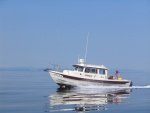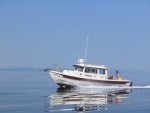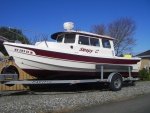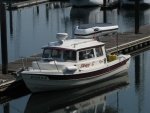"Harvey, why oh why do you think you need bottom paint? We have never used bottom paint in 11 years, and have never observed any consequence from NOT using bottom paint. I'd love to hear your rationale here. Your boat sits on a trailer and is mostly (entirely?) cruised in cold waters at planing speed. What does bottom paint do for you other than give you something to do on the boat?"
Hi Pat,
Two summers ago I spent about 2 months on the water, almost continuously, but there were a couple of trailer haul brakes of 2-3 days scattered in-between so there was some drying time. The longest stretch IIRC was 3 weeks in the water. I had some slime growth to clean each time I pulled, but that was it.
Last summer, I spent almost 3 months in the water. The first break was at 48 days. I had 2 inch hair, fuzz all over and barnacles the size of pencil erasers on the bottom, again in only 48 days. I have about 40 hours in cleaning the bottom, scraping the barnacles, shaving the barnacle roots that are left after the scraping, and unless I do bottom paint, a limitation of a maximum of 3 weeks in the water without getting serious bottom growth AGAIN :twisted:
So, now I am looking at realistically limiting my continuous boating stretches to close to 2 weeks unless I do bottom paint. (I would much rather be spending the $$ on fuel than paint, but looking at long term plans, it seems like the paint is an investment in future boating pleasures.)
Most of my days on the water are spent at anchor, but I moved nearly every day. Some days I would only be on the move for an hour or two, some more than that. Most days, most of my moving time was at 5.5 knots or so. Every day had some time moving at planing speed, which I thought was helping to keep the bottom clean. It was either not enough moving, or not enough moving at planning speeds, or I was wrong :roll:

and moving makes no difference. Time in the water == growth on the bottom.
Seriously, do you really not have bottom paint on Daydream, even with your plans for spending months on the water, warm water, mixed fresh and salt, and in sunny, warm climates. Unless you are planning to haul out and clean I would reconsider, and thing bottom paint for sure. Just guessing, but after several haul outs and hull cleaning fees, you are approaching bottom paint $$$$'s. (I thought Bitter End did bottom paint for you when you had the detailing done and prepping for the Loop.)
Harvey
SleepyC:moon







